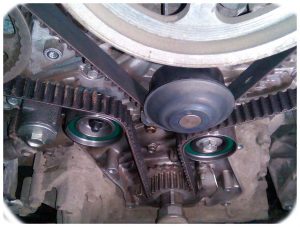If you own a Honda CR-V, it’s important to know when to replace the timing belt and chain. The timing belt and chain are essential components of your vehicle that ensure the engine runs smoothly and efficiently. Understanding how they work, why they need to be replaced, and how often will help keep your car in good condition.
What Is a Timing Belt?

What Is a Timing Chain?
A timing chain is also used in internal combustion engines like that found in Honda CR-Vs, but it serves a slightly different purpose than a timing belt does — providing extra stability throughout its operation under high RPMs (revolutions per minute) and higher engine speeds. Unlike a belt, a chain is made of metal and has no inherent weak points — such as wear or oil contamination — meaning it can last much longer than a belt.
Difference Between a Honda CR-V Timing Belt vs Chain
The main difference between the two components is that the timing belt must be replaced more often than the timing chain does, due to its vulnerability to becoming stretched or contaminated with oil over time. The timing belt can last for as long as 60,000 miles or 6 years, depending on your driving habits and conditions, while the timing chain can last up to 250,000 miles in some cases before needing replacement.
Another distinction between these two components is that when replacing the timing belt, you may need other parts related to it replaced at the same time: tensioner pulleys, cam seals, water pump seals or other items that may need attention due to age or wear-and-tear even if they appear to be in good condition prior to installation of new belts. However, additional parts are not typically needed when replacing a chain since they are generally built more sturdy than belts and rarely have any weak points.
When Should I Replace My Honda CR-V Timing Belt or Chain?
Due to its vulnerability to becoming prematurely worn out, it’s important to replace your Honda CR-V timing belt every 60,000 miles or 6 years, depending on driving conditions and habits. It’s recommended that a professional mechanic inspect your vehicle to ensure that all components are in good working condition before installing the new belt.
For your timing chain, however, it’s unnecessary to have the chain replaced unless there is evidence of excessive wear or damage due to age and mileage. Although it may seem like a good idea to replace the timing chain as preventive maintenance for safety reasons, doing so may create more problems than it solves if the replacement is done too soon and parts become unnecessarily damaged. It’s best practice not to replace any part until there is an indication from a professional mechanic that it needs replacement due to wear and tear or engine damage caused by incorrect installation of other components related to the timing system in your vehicle.
Conclusion
Timing belts and chains are essential components of any internal combustion engine – including those found in Honda CR-Vs. Knowing the difference between a timing belt and chain and when to replace them will help keep your car running smoothly and efficiently. Replacing your Honda CR-V timing belt on schedule is essential due to its vulnerability to wear while replacing a chain before it’s necessary can cause more problems than it solves. Be sure to have your vehicle inspected by a professional mechanic regularly so they can assess the condition of these components and take appropriate action if needed.


Add Comment